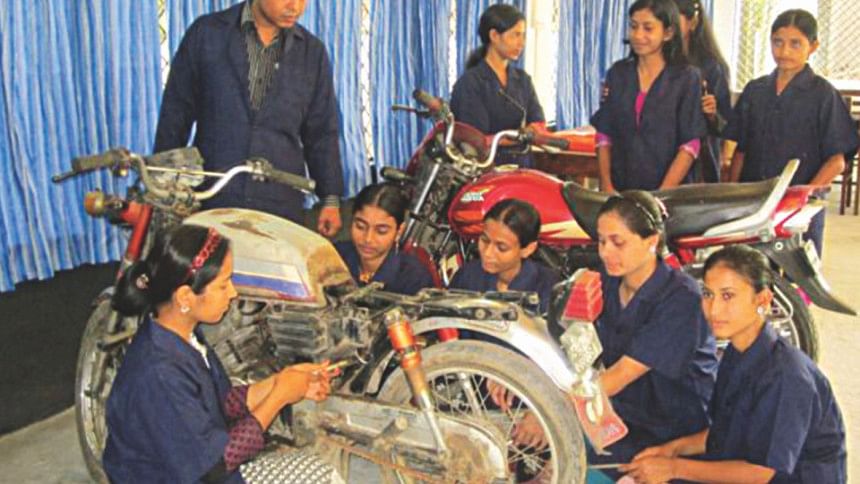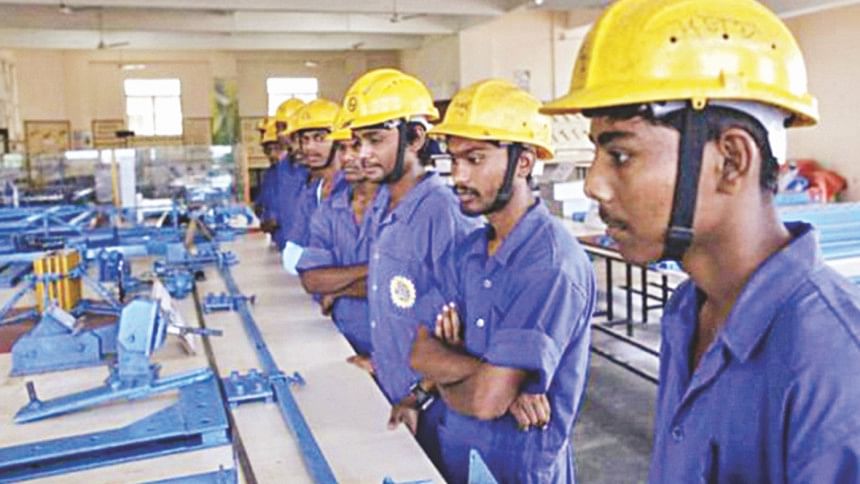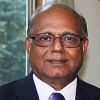Technical and vocational skill training: Expansion alone is not the answer

The inactive youth
Today, around 40 percent of the population aged between 15 and 24 years in Bangladesh are classified as "not in education, employment or training (NEET)", according to a recent ILO report. The actual number adds up to 11.6 million youth or about one-fifth of the total working age population.
ILO's statistical report on Asia-Pacific Decent Work Decade 2006-15 stated that the NEET rate in Bangladesh is the third worst in the region—behind Maldives (56 percent), a small island in the midst of political turmoil; and Yemen (48 percent), wracked by a deadly civil war for the past several years. The rate of youth inactivity is much worse for women—estimated at 62 percent in Bangladesh.
What does the state of youth inactivity of the youth mean the youth themselves and society as a whole? These are youths who have not chosen to be in the situation they are in. They would rather be in school or university, participate in training, or better still, be in a job that pays a decent wage. The prevailing education and training programmes, or the employment market, do not offer them a viable opportunity, at least in their eyes. They are, in academic jargon, described as "at most risk of marginalisation from the labour market and society."
World Bank economist Zahid Hussain has said that the state of youth inactivity is not only an economic wastage, but it is also liable to create social risks. "Many youths cannot secure jobs, depending on their general education. They become easy prey for evil forces that derail them," he said. "They are the people who could produce the demographic dividend, but we are wasting that advantage," he added (Prothom Alo, December 1, 2016).
More than 80 percent of the workers are employed in what is known as the informal economy and informal economic activities that are unregulated, both in urban and rural areas, and are characterised by low skills and low wages, mostly in small enterprises or self-employment.
Debapriya Bhattacharya, Convenor of the Citizen's Platform for SDGs, compared the social tensions arising from the job crisis with a ticking "time bomb". "The youth cannot get decent jobs due to the lack of necessary industrial growth. They are deprived of quality education, and do not have the training required to meet the demands of the employment market," he said.
The state of inactivity of the youth is symptomatic of the larger and deeper problem of misalignment of jobs, skills, the economy, education, and training.
A critical look at skills development
The workforce in Bangladesh amounts to around 60 million. Up to two million young people are entering the workforce each year. Although access to education has grown, the vast majority of the working population lacks general education or occupational skill training.
Data from the last Labour Force Survey of 2013 shows that half of the workers had either no education (21 percent) or less than complete primary education (29 percent). A mere 6 percent had tertiary education.
Extrapolating recent data, it can be surmised that the total skills training opportunities from diploma, certificate and short courses with formal education pre-requisites and course content affiliated to Bangladesh Technical Education Board (BTEB) currently serve only 500,000 trainees each year. Another half million is served by flexible short-duration courses with diverse contents, mostly unregulated by BTEB, and offered mostly by NGOs and private providers. Of this million participating in various skills training, approximately 75 percent on average, according to BTEB estimates, are expected to complete the courses, indicating that the number of workers with some level of skill training stands at about 750,000 annually.
Four points stand out from these figures:
1. A very low level of basic education and general competencies place workers in a low education, low skill, low productivity, and low earning trap.
2. For a national work force of around 60 million (of which one-third is in the 15-24 age group), low and mid-level skills development provisions for about a million trainees (and 750,000 completers) per year cannot be considered adequate.
3. The balance between diploma level and certificate and basic level training is clearly a problem. With workers overwhelmingly engaged in low-skill work, only a small fraction of such workers are served by the training provisions.
4. The inadequacies in numbers and balance are symptomatic of weaknesses in market responsiveness, quality, and relevance of the training courses, further discussed below.
Two other related points are relevant about skills development, education, and training. First is the issue of informal employment and skills. More than 80 percent of the workers are employed in what is known as the informal economy and informal economic activities that are unregulated, both in urban and rural areas, and are characterised by low skills and low wages, mostly in small enterprises or self-employment. The technical and vocation education and training (TVET) system does little for the vast number of workers in the informal economy. There is a large co-incidence between the lack of skills development opportunities, low skill status of workers, low productivity and low earnings of informal sector workers. Changing these conditions to those characterised as decent work, with better productivity, earnings and social protection is a major challenge for skills development and job creation in Bangladesh.
Second is the need for a broader view of skill development. It is evident that the commonly used term TVET can be confining and has to be broadened to embrace all forms of technical and vocational skills development (TVSD). A skill development system that serves fewer than 20 percent of the workers, which is the case with the recognised TVET that exists today, is obviously not the total system. The policy development and action priorities have to be based on a broader view of the system.
SDG skills goals
The question of youth employment, education and training has gained prominence as one of the 17 United Nations' Sustainable Development Goals (SDGs) to promote "decent work for all", namely Goal 8. Bangladesh has endorsed the global SDG goals and incorporated them into its national development goals.

The 12 targets related to Goal 8 include macroeconomic measures supportive of job growth, development-oriented policies that support productive activities, policies to achieve full and productive employment and decent work for all women and men, including young people and persons with disabilities, and reducing the proportion of youth not in employment, education, or training. Targets are also indicated for protecting labour rights and promoting safe and secure working environments for all workers, including migrant workers, women migrants in particular, and those in precarious employment.
The overarching SDG goal regarding inclusive and quality education for all and lifelong learning includes targets, which directly address education and training for skills development. These are:
4.3. By 2030, ensure equal access for all women and men to affordable and quality technical, vocational, and tertiary education, including university education.
4.4. By 2030, substantially increase the number of youth and adults who have relevant skills, including technical and vocational skills, for employment, decent jobs, and entrepreneurship.
4.5. By 2030, eliminate gender disparities in education and ensure equal access to all levels of education and vocational training for the vulnerable, including persons with disabilities, indigenous peoples and children in vulnerable situations.
4.6. By 2030, ensure that all youth and a substantial proportion of adults, both men and women, achieve literacy and numeracy.
The 2020 target of full female literacy repeats past 'illiteracy eradication' targets, which were repeatedly missed and not very meaningful.
At the national level, government plans and programmes as reflected in the 7th Five Year Plan of Bangladesh (2016-2020) include:
1. Emphasis on promoting labour mobility in both farm and non-farm sectors to expand employment and increase vocational/ICT training for youth
2. Enrolment in TVET raised to 20 percent by 2020 from the present 14 percent
3. One million trained people for the ICT industry by 2020
4. Promote gender equality in TVET; by 2020, increase female enrolment in technical and vocational education to 40 percent; and reduce current female income inequality ratio
5. ICT training facilities for youth/adult; improved tele-density to 100 percent; 100 percent internet penetration and 50 percent broadband coverage of population
6. 30 percent of primary schools and 100 percent of all secondary schools to have an ICT laboratory; expand digital services, financial services, health clinics (tele-consultation); most vital government services made available at Digital Centres—all of which will expand demand for digital skills and employment in digital services.
7. Once again, a target of 100 percent literacy is announced with target date of 2020. A plan for establishing a network of community learning centres is mentioned, but not specifically linked to literacy and lifelong learning.
A few pertinent observations about SDG goals and government plans can be made:
1. The emphasis on the mobility of workers and on the service sector, especially digital services, shows a much deserved recognition of the change in the employment structure and new opportunities.
2. Present overall TVET participation is low—lower still for females. It is characterised by low outreach and high gender disparity, especially in non-formal/flexible shorter courses. There is no major programme for skill training for informal economy jobs; and there are very limited formal/informal apprenticeship opportunities.
3. It is questionable if expansion within the present structure without significant reforms will help to reach the targets set.
4. Despite primary and secondary education gender parity in enrolment, disparity remains in completion and transition at secondary level and beyond; disparities persist in TVET and higher education.
5. The 2020 target of full female literacy repeats past 'illiteracy eradication' targets, which were repeatedly missed and not very meaningful. Adult literacy gender disparity has narrowed, but not been fully eradicated. A viable programme for literacy as the foundation for lifelong learning through networks of community learning centres (CLCs) and wide and equitable access to ICT is yet to be developed.
Diverse skills' formation opportunities, which are market responsive, with a strong private-public partnership, approach are needed. The emphasis has to be on ensuring quality and relevance rather than just expanding existing institutions and programmes.
The potential of digital technology
Speaking at the Digital Leaders' Policy Meeting on Jobs at the 2017 World Economic Forum 2017 in Davos, Switzerland, Prime Minister Sheikh Hasina presented a bold and forward-looking vision for the future of the skills and jobs front. She said Bangladesh wanted to expose millions of its youths to the most advanced technologies, knowledge, and skills. "Our aim is to bridge the knowledge and technological gaps within our societies, as well as with the outside world," she said.
The Prime Minister said Bangladesh would continue to have a youthful population for at least the next three decades. In terms of strategy, she stated that Bangladesh is employing technology and related knowledge solutions to: (a) enhance human capital and skills, (b) deliver critical services effectively, and (c) create the right synergies between knowledge, skills, and employment (Asian Age, January 21, 2017).
As essential elements of the political vision—Vision 2021 (graduating to middle income country status) and Vision 2041 (becoming a developed nation), the Prime Minster listed various steps that have been initiated:
1. A National Roadmap on ICT in Education with a focus on ICT for education, not just ICT education, to develop our children's competencies through digital learning contents. For example, Bangladesh now has over 23,000 multimedia classrooms in secondary schools; and around 14,000 are to be set up in primary schools.
2. Around 150,000 high school teachers countrywide are registered under a unique online social platform called Teachers' Portal in which contents developed by teachers are shared. The plan is to sign up all 900,000 high school teachers by 2021.
3. A wider e-learning platform, Mukto Path, is to be established as Bangladesh's Coursera (an on-line platform which offers free courses from a consortium of top US universities), which will help Bangladeshis anywhere develop skills, create jobs and diversify their skills portfolio.
Diverse skills' formation opportunities, which are market responsive, with a strong private-public partnership, approach are needed. The emphasis has to be on ensuring quality and relevance rather than just expanding existing institutions and programmes.
4. The government is assessing changing patterns of work, analysing the market situation, and prioritising skills development, by dynamically linking with manufacturing and service industries. An 'inclusive' approach embracing formal and informal sectors and the disadvantaged groups across the economy is to be pursued.
5. A National Skills Development Authority is to be set up to address the entire ecology of skills and work, with a unique 'Skills and Employment Dashboard' to coordinate and monitor all skills development initiatives across sectors. A revamped and rebranded TVET with a 360 Degree Human Development Media Platform is in plans so as to make TVET "exciting, recognised, dignified and current."
6. Over 4,500 Union Digital Centres, connecting every nook and corner of Bangladesh, have created a new economy, and every month, these centres deliver over five million services which have saved poor citizens over half a billion dollars since 2010 and created 10,000 new digital self-employment opportunities. Today, Bangladesh has a pool of half a million IT freelancers and the government is encouraging more women freelancers to join the pool.
7. Over 600 pilot initiatives across healthcare, education, crops, fisheries, land, and human rights have been supported through a Service Innovation Fund. These are to be scaled up with 'one-stop services' offered by self-employed entrepreneurs (Asian Age, January 21, 2017).
The Prime Minister's statement offers a vision of skills and capability enhancement befitting an aspiring middle income country. The overall situation of basic education, skills and jobs described above has to be addressed to fulfil the ambitions and expectations the Prime Minister conveyed in her speech at Davos.
The writer is Professor Emeritus at the BRAC University Institute of Educational Development (BRACU-IED), of which he was the founder-director. He has been Chair of the Bangladesh Early Childhood Development Network (BEN), and has served for over two decades in senior positions in UNICEF, including as Senior Education Adviser and Country Director in China, Ethiopia and Japan.

 For all latest news, follow The Daily Star's Google News channel.
For all latest news, follow The Daily Star's Google News channel. 



Comments